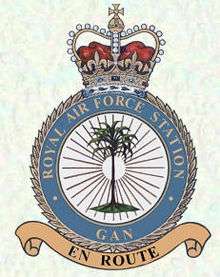RAF Gan
Royal Air Force Station Gan commonly known as RAF Gan, is a former Royal Air Force station on Gan Island, the southern-most island of Addu Atoll which is part of the larger groups of islands which form the Maldives, in the middle of the Indian Ocean. The airfield is now Gan International Airport.
RAF Gan | |||||||||||
|---|---|---|---|---|---|---|---|---|---|---|---|
 En Route | |||||||||||
| Summary | |||||||||||
| Airport type | Military | ||||||||||
| Owner | Ministry of Defence | ||||||||||
| Location | Gan island, Maldives | ||||||||||
| Built | 1957 | ||||||||||
| In use | 1957-1 April 1976 | ||||||||||
| Elevation AMSL | 6 ft / 2 m | ||||||||||
| Coordinates | 00°41′29″S 073°09′22″E | ||||||||||
| Map | |||||||||||
 RAF Gan Location in the Maldives | |||||||||||
| Runways | |||||||||||
| |||||||||||
History
The area was originally established as a military base for the Royal Navy in 1941. Royal Navy engineers began constructing airstrips on Gan island in August 1941 for the Fleet Air Arm.
During World War II, in 1942 the RAF had its bases in the islands of Addu Atoll, Maldives. The RAF first had a presence on Hithadoo in 1942 when a detachment of RAF personnel were sent from RAF China Bay in Ceylon to service and turn around the RAF Short Sunderland and PBY Catalina flying boats that were flying regularly into the Addu Atoll lagoon. At the end of the war, all military installations were either removed or abandoned.
In 1956-57, at the request of SWRD Bandaranaike, the Royal Air Force handed over its bases in Ceylon to the Royal Ceylon Air Force. The loss of RAF Negombo meant that a replacement staging post was needed between its bases in the Middle East and Far East and the location was virtually limited to Gan. Hence Royal Air Force Station Gan became established in the late 1950s as a stopover on the reinforcement route to the Far East Air Force based in Singapore. The previous reinforcement route had passed through countries that had formerly been British territory but were now independent, and sometimes hostile nations. RAF Mauripur, to the west of Karachi, by then a Pakistan Air Force station, had RAF personnel attached for staging airfield purposes up until 1956, when the staging role between the Middle East and Far East fell to RAF Gan.[1]
It was extensively used as a staging post by bombers, fighters and transports on their way to Singapore and other destinations in east Asia during the late 1950s and the 1960s. Other foreign military forces, like the US, occasionally used the facilities. However, as the 1970s dawned, the United Kingdom was withdrawing from its commitments east of the Suez. By the end of 1971 the RAF Far East Air Force was disbanded and the major rationale for Gan was gone. Traffic was now much less frequent but the base still remained open for a few more years. By 1975 British military aircraft using the base were an extreme rarity. RAF Gan was thus closed and on 1 April 1976 the island was handed back to the Maldivian Government. At the same time as RAF use of the airfield ceased, the RAF gained access to the then newly built US airfield 200 miles (320 km) to the south of Gan on the British island of Diego Garcia.
RAF Gan today
Following the handover back to the Maldivian Government, the island was left to fall into disrepair for many years, but as funds allowed the airfield was subtly developed into a civil airport, and is now known as Gan International Airport. Most of the base is now a tourist resort called Equator Village: the military buildings remain and have been converted into rooms and other facilities on the resort. The hospital is now a dive centre.
References
Citations
- Jefford 1988, p. 00.
- Airport information for VRMG at World Aero Data. Data current as of October 2006.
Bibliography
- Jefford, C.G. RAF Squadrons, a Comprehensive Record of the Movement and Equipment of all RAF Squadrons and their Antecedents since 1912. Shrewsbury, Shropshire, UK: Airlife Publishing, 1988. ISBN 1-84037-141-2.
